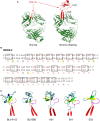Diversity in the Cow Ultralong CDR H3 Antibody Repertoire
- PMID: 29915599
- PMCID: PMC5994613
- DOI: 10.3389/fimmu.2018.01262
Diversity in the Cow Ultralong CDR H3 Antibody Repertoire
Abstract
Typical antibodies found in humans and mice usually have short CDR H3s and generally flat binding surfaces. However, cows possess a subset of antibodies with ultralong CDR H3s that can range up to 70 amino acids and form a unique "stalk and knob" structure, with the knob protruding far out of the antibody surface, where it has the potential to bind antigens with concave epitopes. Activation-induced cytidine deaminase (AID) has a proven role in diversifying antibody repertoires in humoral immunity, and it has been found to induce somatic hypermutation in bovine immunoglobulin genes both before and after contact with antigen. Due to limited use of variable and diversity genes in the V(D)J recombination events that produce ultralong CDR H3 antibodies in cows, the diversity in the bovine ultralong antibody repertoire has been proposed to rely on AID-induced mutations targeted to the IGHD8-2 gene that encodes the entire knob region. In this review, we discuss the genetics, structures, and diversity of bovine ultralong antibodies, as well as the role of AID in creating a diverse antibody repertoire.
Keywords: activation-induced cytidine deaminase; antibody; antibody repertoire; cow immunoglobulin; ultralong CDRH3.
Figures


Similar articles
-
Broadly Neutralizing Bovine Antibodies: Highly Effective New Tools against Evasive Pathogens?Viruses. 2020 Apr 22;12(4):473. doi: 10.3390/v12040473. Viruses. 2020. PMID: 32331321 Free PMC article. Review.
-
The Unusual Genetics and Biochemistry of Bovine Immunoglobulins.Adv Immunol. 2018;137:135-164. doi: 10.1016/bs.ai.2017.12.004. Epub 2018 Feb 9. Adv Immunol. 2018. PMID: 29455846 Free PMC article.
-
A Broad Role for Cysteines in Bovine Antibody Diversity.Immunohorizons. 2019 Oct 16;3(10):478-487. doi: 10.4049/immunohorizons.1900058. Immunohorizons. 2019. PMID: 31619454 Free PMC article.
-
Bos taurus ultralong CDR H3 antibodies.Curr Opin Struct Biol. 2016 Jun;38:62-7. doi: 10.1016/j.sbi.2016.05.004. Epub 2016 Jun 10. Curr Opin Struct Biol. 2016. PMID: 27295423 Free PMC article. Review.
-
Immunogenetic factors driving formation of ultralong VH CDR3 in Bos taurus antibodies.Cell Mol Immunol. 2019 Jan;16(1):53-64. doi: 10.1038/cmi.2017.117. Epub 2017 Dec 4. Cell Mol Immunol. 2019. PMID: 29200193 Free PMC article.
Cited by
-
The smallest functional antibody fragment: Ultralong CDR H3 antibody knob regions potently neutralize SARS-CoV-2.Proc Natl Acad Sci U S A. 2023 Sep 26;120(39):e2303455120. doi: 10.1073/pnas.2303455120. Epub 2023 Sep 18. Proc Natl Acad Sci U S A. 2023. PMID: 37722054 Free PMC article.
-
Evolution of phage display libraries for therapeutic antibody discovery.MAbs. 2023 Jan-Dec;15(1):2213793. doi: 10.1080/19420862.2023.2213793. MAbs. 2023. PMID: 37222232 Free PMC article. Review.
-
Bovine Ultra-Long CDR H3 Specific for Bovine Rotavirus Displays Potent Virus Neutralization and Therapeutic Effects in Infected Calves.Biomolecules. 2025 May 8;15(5):689. doi: 10.3390/biom15050689. Biomolecules. 2025. PMID: 40427582 Free PMC article.
-
Broadly Neutralizing Bovine Antibodies: Highly Effective New Tools against Evasive Pathogens?Viruses. 2020 Apr 22;12(4):473. doi: 10.3390/v12040473. Viruses. 2020. PMID: 32331321 Free PMC article. Review.
-
Structural basis of broad HIV neutralization by a vaccine-induced cow antibody.Sci Adv. 2020 May 27;6(22):eaba0468. doi: 10.1126/sciadv.aba0468. eCollection 2020 May. Sci Adv. 2020. PMID: 32518821 Free PMC article.
References
-
- Chehimi J, Valiante NM, D’andrea A, Rengaraju M, Rosado Z, Kobayashi M, et al. Enhancing effect of natural killer cell stimulatory factor (NKSF/interleukin-12) on cell-mediated cytotoxicity against tumor-derived and virus-infected cells. Eur J Immunol (1993) 23:1826–30.10.1002/eji.1830230814 - DOI - PubMed
Publication types
MeSH terms
Substances
Grants and funding
LinkOut - more resources
Full Text Sources
Other Literature Sources

